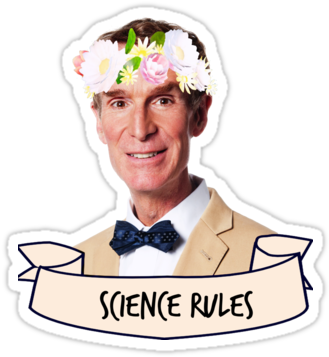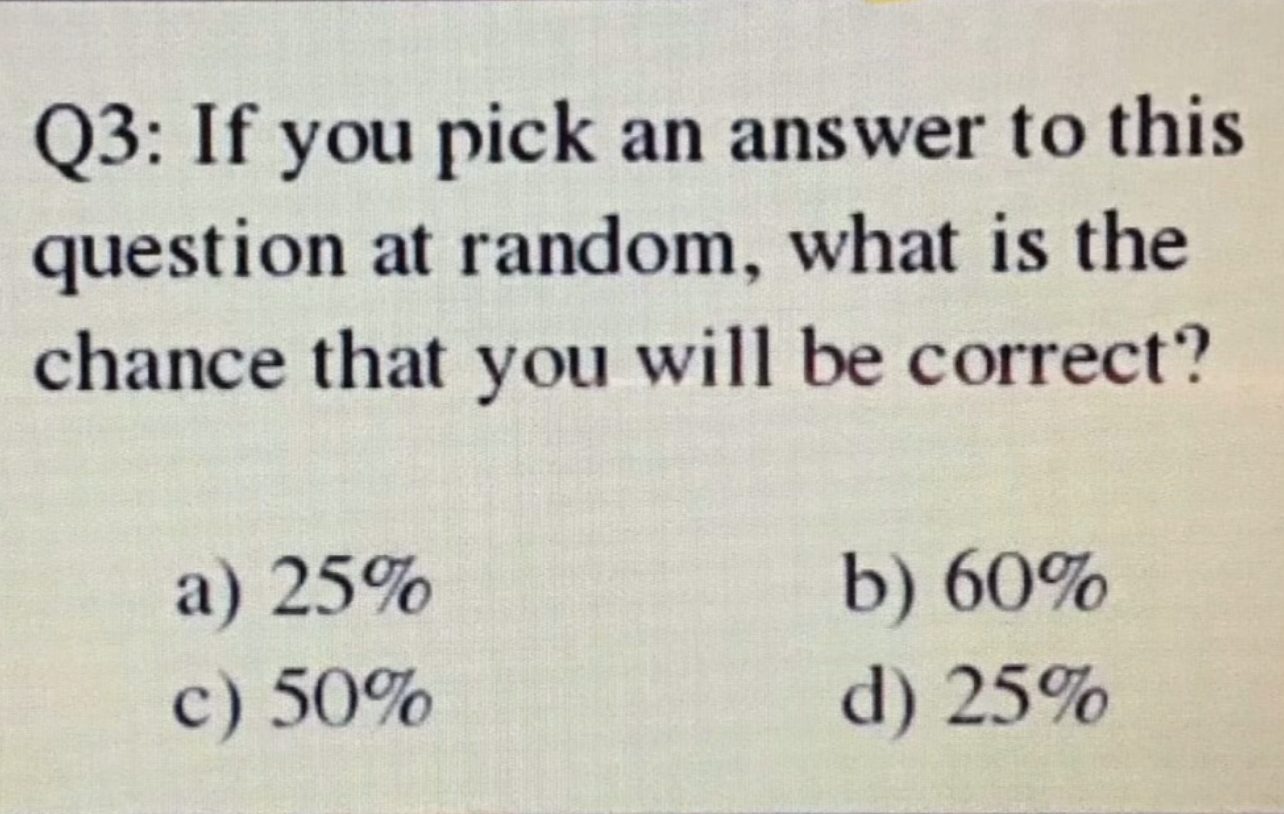It's 0%, because 0% isn't on the list and therefore you have no chance of picking it. It's the only answer consistent with itself. All other chances cause a kind of paradox-loop.
Science Memes
Welcome to c/science_memes @ Mander.xyz!
A place for majestic STEMLORD peacocking, as well as memes about the realities of working in a lab.

Rules
- Don't throw mud. Behave like an intellectual and remember the human.
- Keep it rooted (on topic).
- No spam.
- Infographics welcome, get schooled.
This is a science community. We use the Dawkins definition of meme.
Research Committee
Other Mander Communities
Science and Research
Biology and Life Sciences
- !abiogenesis@mander.xyz
- !animal-behavior@mander.xyz
- !anthropology@mander.xyz
- !arachnology@mander.xyz
- !balconygardening@slrpnk.net
- !biodiversity@mander.xyz
- !biology@mander.xyz
- !biophysics@mander.xyz
- !botany@mander.xyz
- !ecology@mander.xyz
- !entomology@mander.xyz
- !fermentation@mander.xyz
- !herpetology@mander.xyz
- !houseplants@mander.xyz
- !medicine@mander.xyz
- !microscopy@mander.xyz
- !mycology@mander.xyz
- !nudibranchs@mander.xyz
- !nutrition@mander.xyz
- !palaeoecology@mander.xyz
- !palaeontology@mander.xyz
- !photosynthesis@mander.xyz
- !plantid@mander.xyz
- !plants@mander.xyz
- !reptiles and amphibians@mander.xyz
Physical Sciences
- !astronomy@mander.xyz
- !chemistry@mander.xyz
- !earthscience@mander.xyz
- !geography@mander.xyz
- !geospatial@mander.xyz
- !nuclear@mander.xyz
- !physics@mander.xyz
- !quantum-computing@mander.xyz
- !spectroscopy@mander.xyz
Humanities and Social Sciences
Practical and Applied Sciences
- !exercise-and sports-science@mander.xyz
- !gardening@mander.xyz
- !self sufficiency@mander.xyz
- !soilscience@slrpnk.net
- !terrariums@mander.xyz
- !timelapse@mander.xyz
Memes
Miscellaneous
This is a paradox, and I don't think there is a correct answer, at least not as a letter choice. The correct answer is to explain the paradox.
You can rationalize your way to exclude all but a last answer, there by making it the right answer.
Like, seeing as there are two 25% options, so there aren't four different answers, which means there isn't a 25% chance. This lead to there only being two options left 50% or 60%. This would seem to make 50% the right answer, but it's not, because you know the options, so it's not random, which in turn means you're not guessing. So you have more that 50% chance of choosing the right answer. So 60% is the closest to a right answer, by bullshitting and gaslighting yourself into thinking you solved question.
Paradoxes aside, if you're given multiple choices without the guarantee that any of them are correct, you can't assign a chance of picking the right one at random anyway.
33% innit
iis
It is 33% if the answer itself is randomly chosen from 25%, 50%, and 60%. Then you have:
If the answer is 25%: A 1/2 chance of guessing right
If the answer is 50%: A 1/4 chance of guessing right
If the answer is 60%: A 1/4 chance of guessing right
And 1/3*1/2 + 1/3*1/4 + 1/3*1/4 = 1/3, or 33.333...% chance
If the answer is randomly chosen from A, B, C, and D (With A or D being picked meaning D or A are also good, so 25% has a 50% chance of being the answer) then your probability of being right changes to 37.5%.
This would hold up if the question were less purposely obtuse, like asking "What would be the probability of answering the following question correctly if guessing from A, B, C and D randomly, if its answer were also chosen from A, B, C and D at random?", with the choices being something like "A: A or D, B: B, C: C, D: A or D"
This seems like a version of the Liar paradox. Assume "this statement is false" is true. Is the statement true or false?
There are a bunch of ways to break the paradox, but they all require using a system that doesn't allow it to exist. For example, a system where truth is a percentage so a statement being 50% true is allowed.
For this question, one way to break the paradox would be to say that multiple choice answers must all be unique and repeated answers are ignored. Using that rule, this question only has the answers a) 25%, b) 60%, and c) 50%, and none of them are correct. There's a 0% chance of getting the correct answer.
50/50, you either guess it right or you dont
If you suppose a multiple choice test MUST ONLY have one correct answer:
-
Eliminate duplicate 25% answers
-
You are left with 60% and 50% as potential answers to this question.
-
C is the answer
If you were to actually select an answer at random to this question while believing the above, you would have a 50% chance of answering 25%.
It is obvious to postulate that: for all multiple choice questions with no duplicate answers, there is a 25% chance of selecting the correct answer.
However as you can see, in order to integrate the answer being C with the question itself, we have to destroy the constraints of the solution and treat the duplicate 25% answers as one sum correct answer.
Do you choose to see the multiple choice answer space as an expression of the infinite space of potential free form answers? Was the answer to the question itself an expression of multiple choice probability or was it the answer from the free form answer space condensed into the multiple choice answer space?
The question demonstrates arriving at different answers between inductive and deductive reasoning. The answer depends on whether we are taking the answers and working backwards or taking the question and working forwards. The question itself forces the inductive reasoning strategy to falter at the duplicate answers, leading to deductive reasoning being the remaining strategy. Some may choose to say "there is no answer" in the presence of needing to answer a question that only has an answer because we are forced to pick one option, and otherwise would be invalid. Some may choose to point out it is obviously a paradox.
The answer is not available. The answer is 0 Percent. Each answer, if chosen, would be incorrect. If 0% was an answer, it would be the correct one despite being a 25% chance. Of course, if one 25% was there, that would be the correct answer.
But if you did randomly choose the 0% option, you'd be correct. So if one of the possible answers was 0% the correct answer would be 25%.
